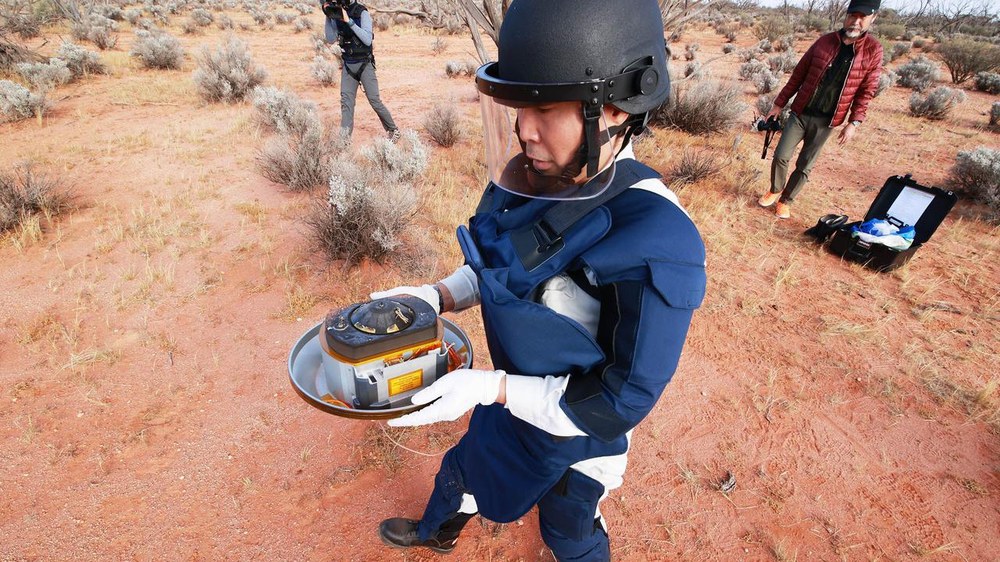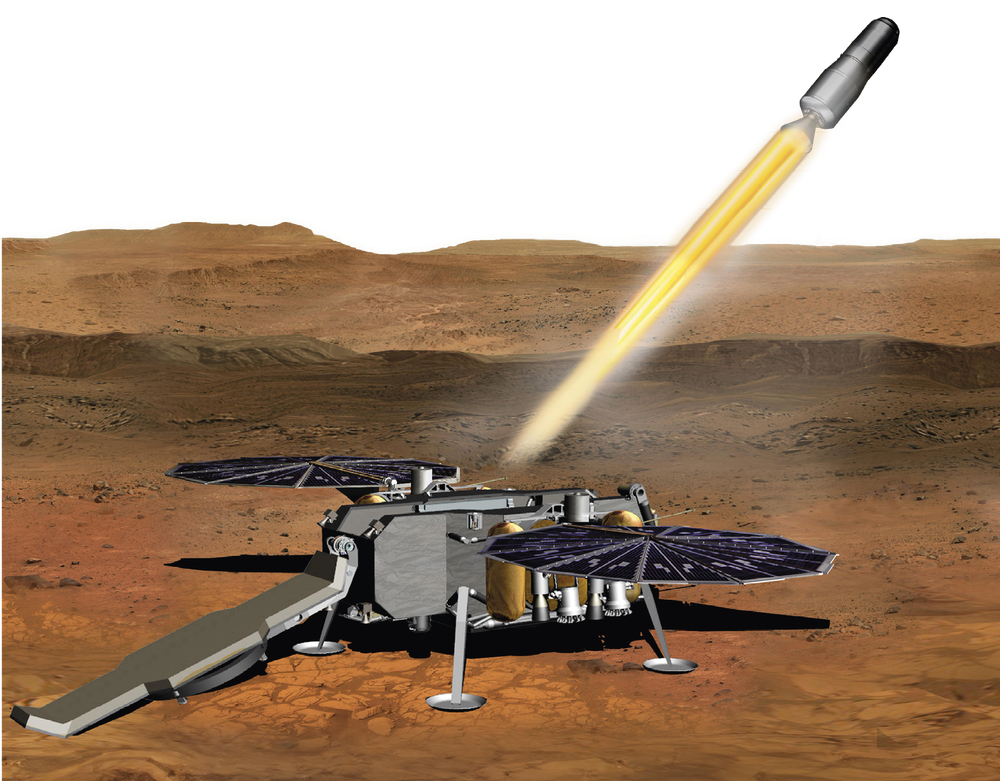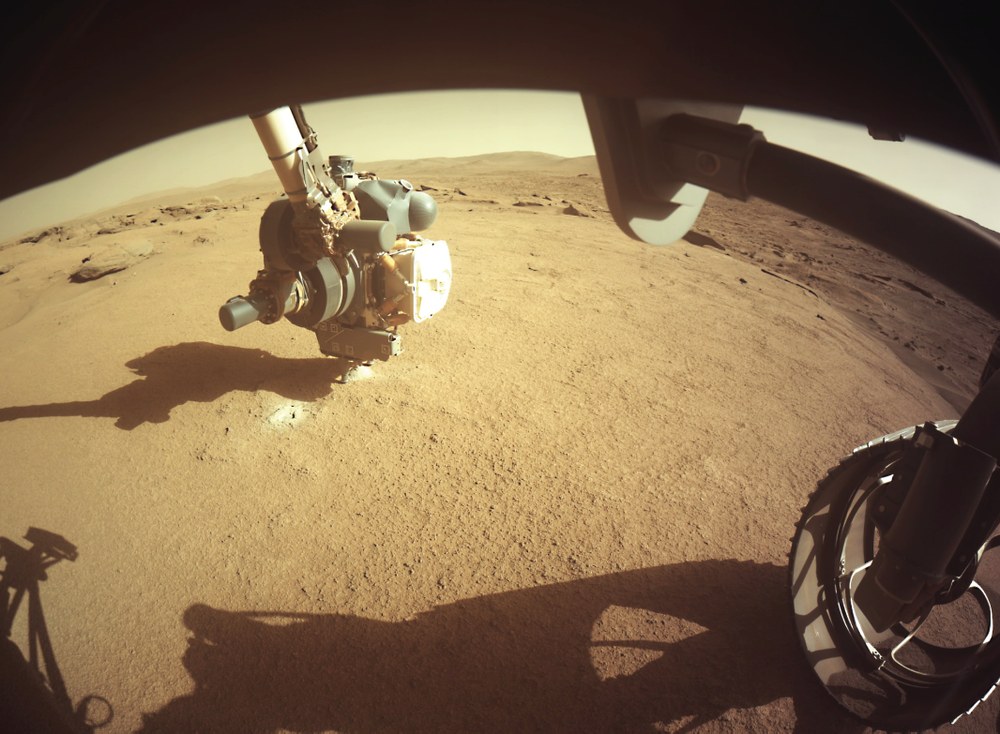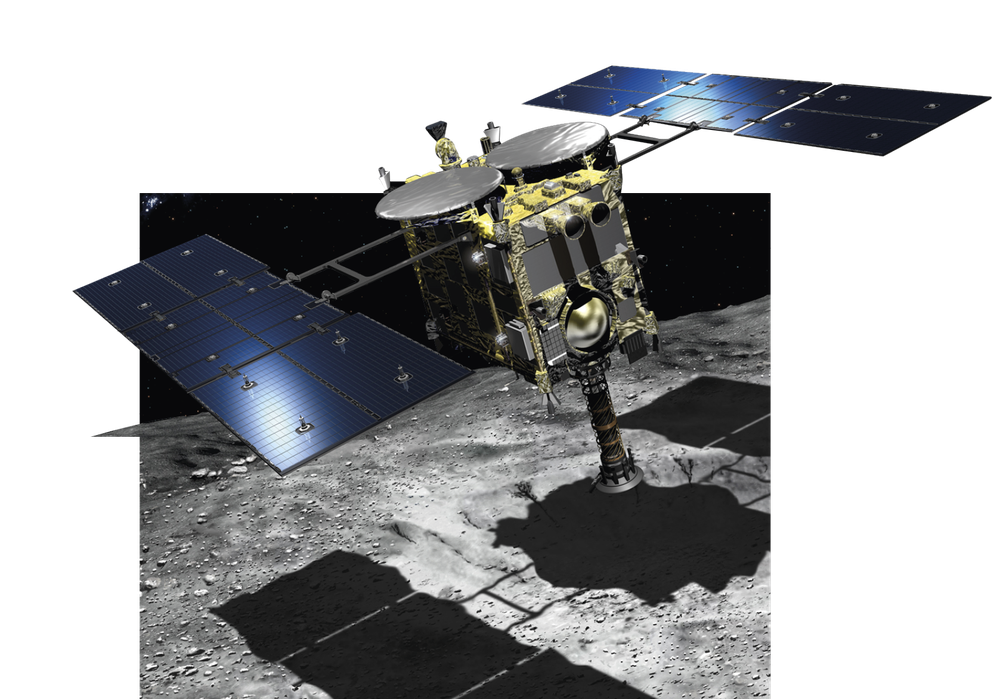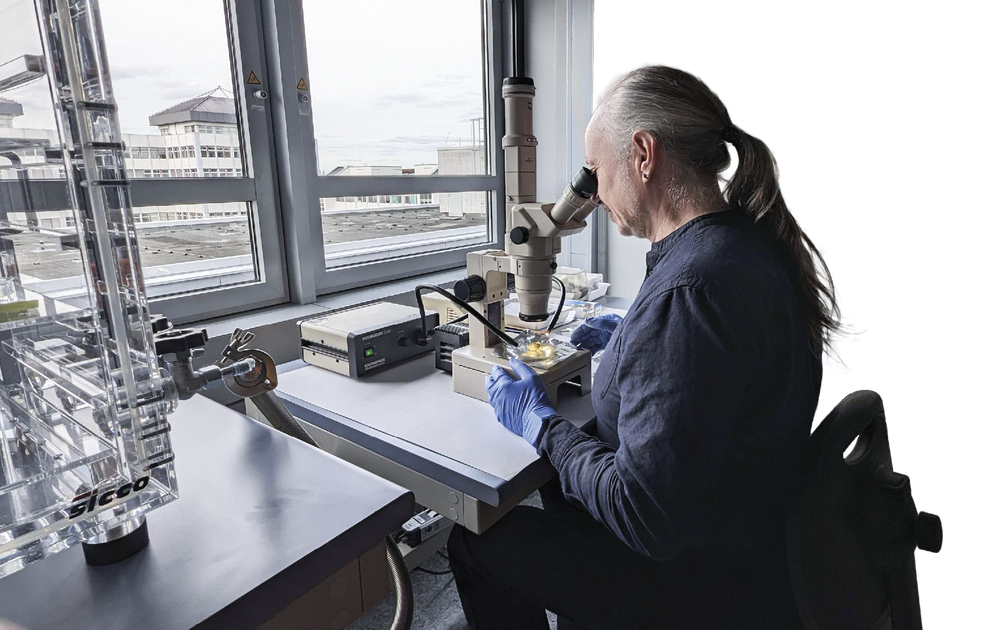The Falcon's Precious Prey
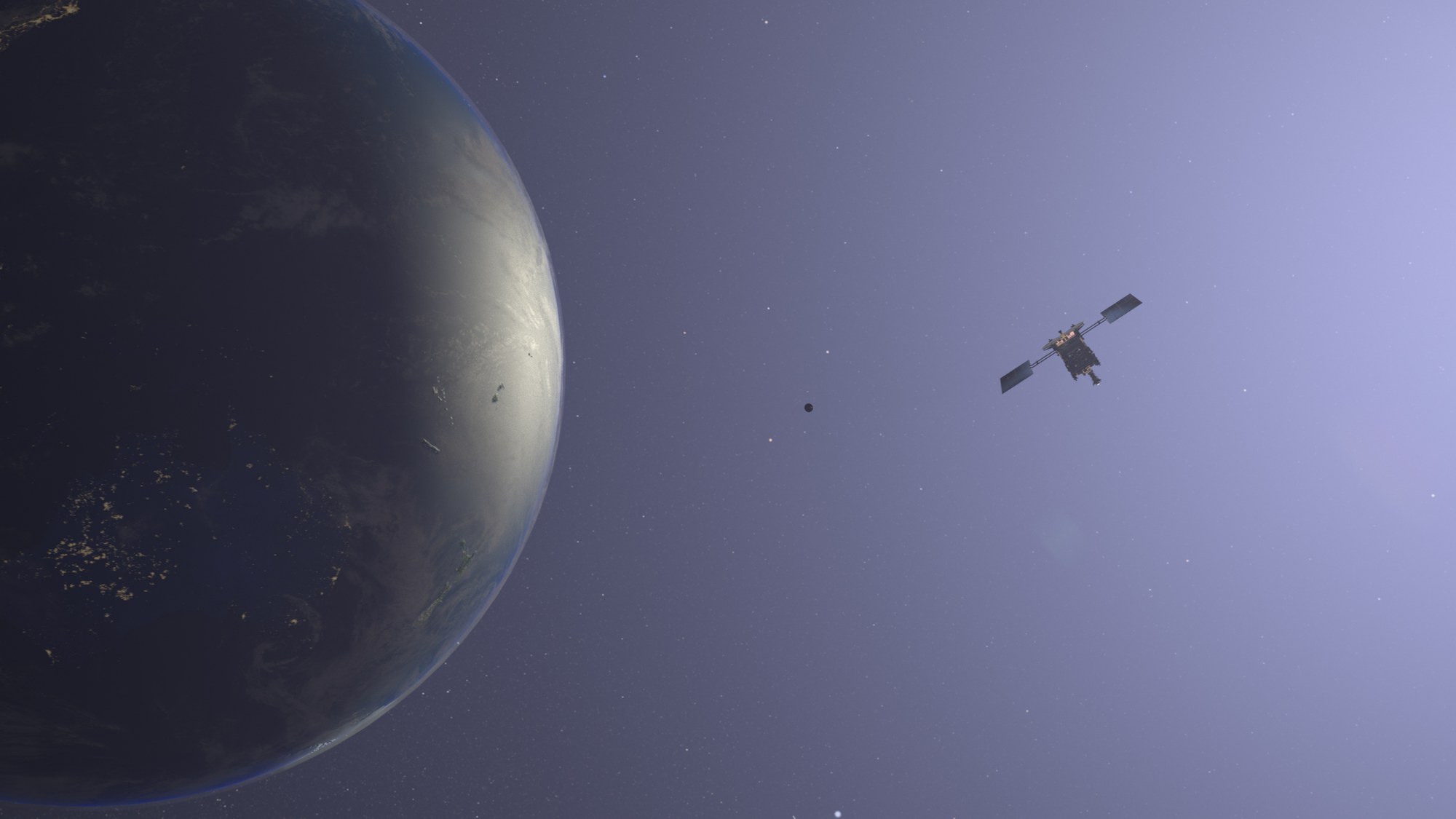
25 August 2022. There is a palpable nervous tension in the laboratory wing of the DLR Institute of Planetary Research. They are expecting a delivery today, but there is nothing ordinary about it. The delivery – somewhat prosaically delivered via parcel post – will contain a speck of dust billions of years old. It arrives without security arrangements or any great fanfare. A signature later, and Giulia Alemanno and Alessandro Maturilli cradle the nitrogen-filled sample container made of stainless steel and plexiglass in their hands. Since that day, the team has analysed 'A0112' in minute detail. Samples collected by spacecraft that are brought to Earth are extremely valuable for science because they tell stories about the origins of our planets and the Solar System.
This particular sample was 'dropped off' by the Japanese Hayabusa2 spacecraft, whose target was asteroid Ryugu. On 5 December 2020, the spacecraft brought samples from the asteroid to Earth. Hayabusa means 'Peregrine Falcon' in Japanese. The hermetically sealed sample container contained over five grams of material – much more than anyone had hoped for. Thanks to sophisticated analysis techniques available today, this seemingly small sample counts as a huge amount, and is of inestimable scientific value. The samples are over 4.5 billion years old, almost the same age as the Solar System.
Sample return – the pinnacle of space exploration
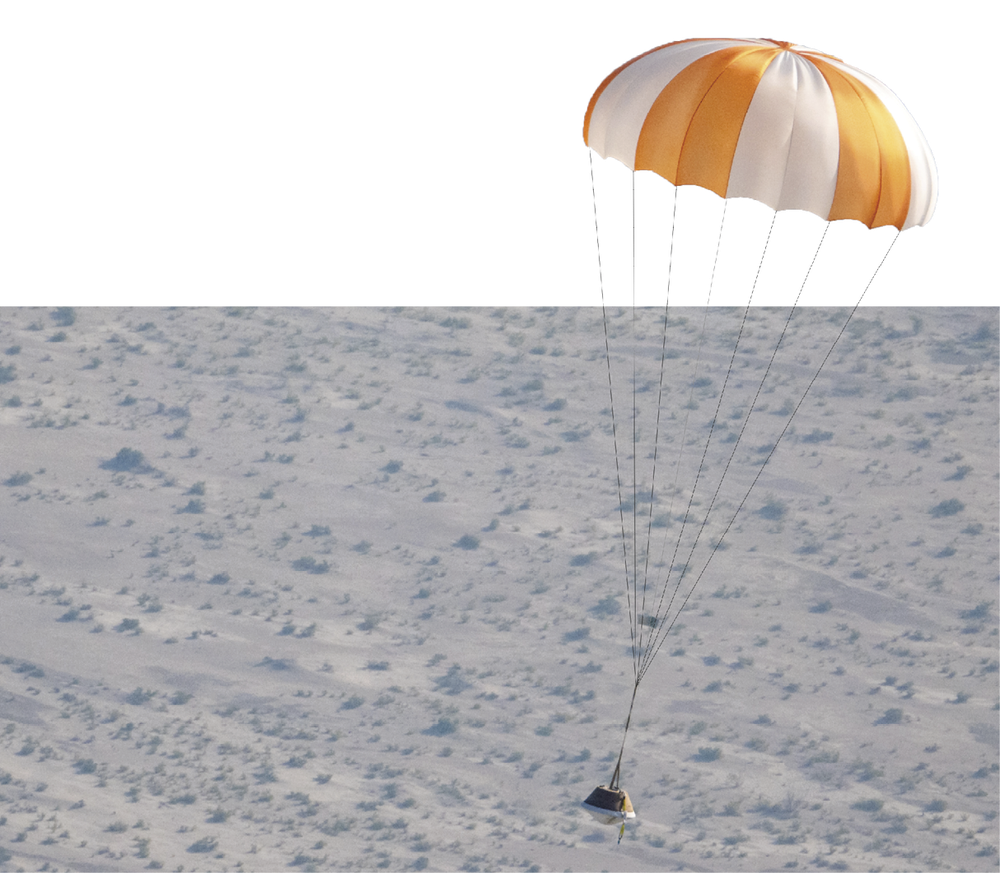
NASA (Keegan Barber)
Being able to examine samples on Earth from another celestial body is hugely significant. Of course, the capabilities of today's telescopic instruments are enormous, not least because they can be aimed at their target objects from a great distance. By examining high-resolution images of the surfaces of these bodies, scrutinising their material composition with various spectrographs and measuring an array of physical parameters, researchers get a comprehensive picture of the planets, moons and even small bodies in the Solar System. These findings are even more accurate if physical samples are obtained from celestial bodies in a targeted way – from locations that have already been carefully observed and have a known geological context – and are then taken to laboratories on Earth. There they can be analysed by hundreds of scientists using powerful equipment for months, years and even decades on end. Over the course of almost seven decades of space exploration, the highly complex robotic extraction of samples from distant bodies and their return has become possible, having once been unimaginable.

NASA
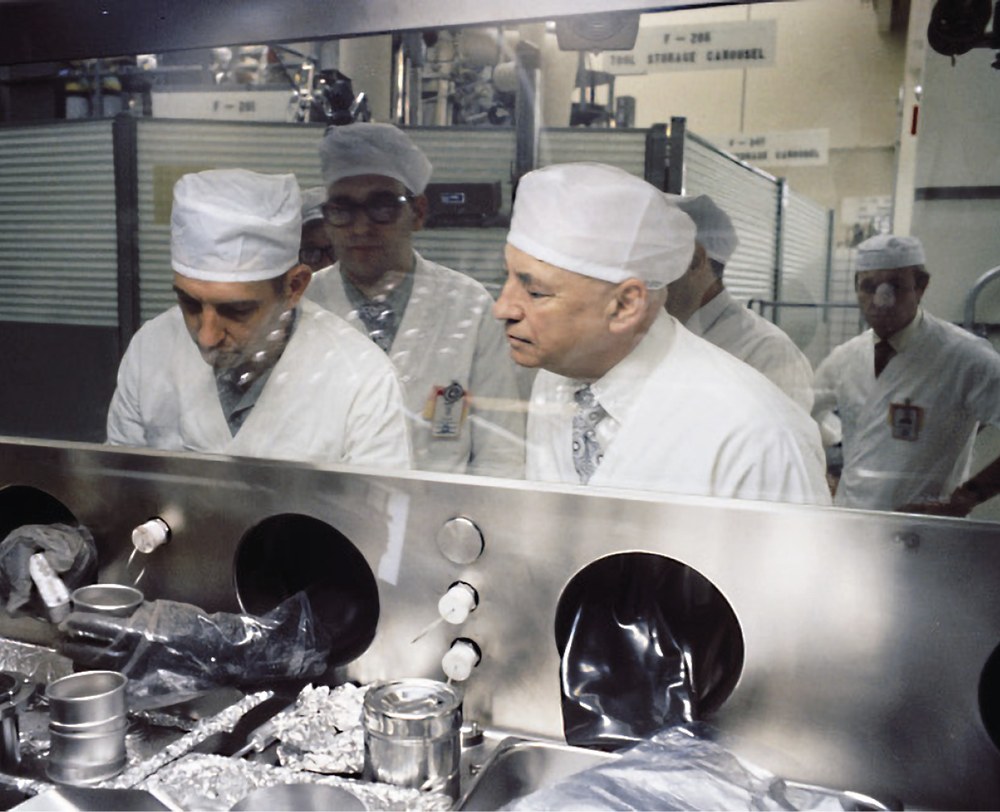
NASA/JSC
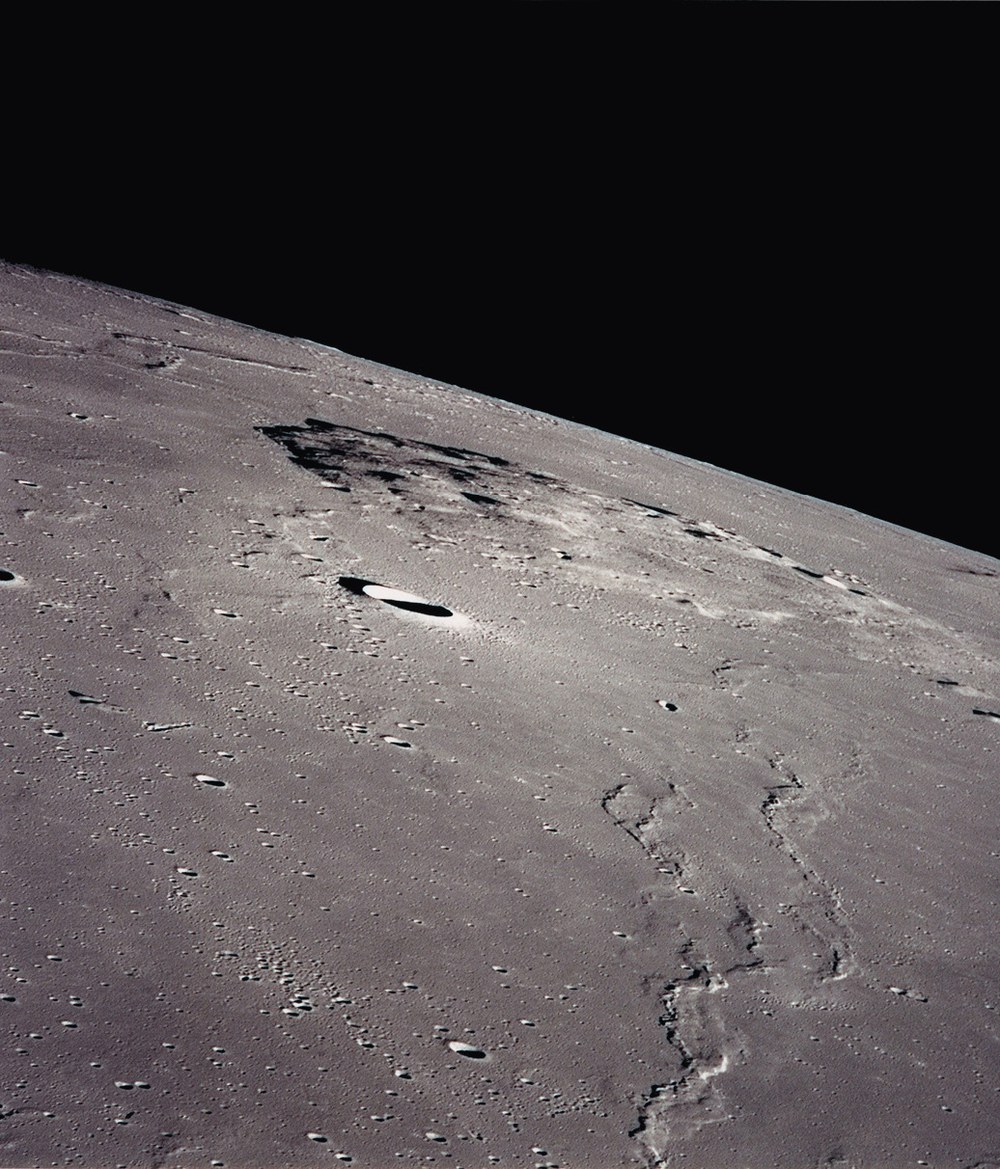
NASA
Almost 400 kilograms of Moon rock transported to Earth
This supreme discipline of space exploration began with the astronauts on the Apollo missions, collecting rocks on the Moon by hand, equipped with standard geology hammers. In total, they brought 2415 individual samples weighing 382 kilograms to Earth. Now, as then, this is the Holy Grail of planetary research. Between 1970 and 1976, the Soviet space programme demonstrated that such samples could also be collected automatically – probes 16, 20 and 24 of the Luna series returned to Earth with a total of 321 grams of drilled lunar dust. China also brought samples to Earth in 2020, after the Chang'e 5 lander touched down near the relatively young volcano Mons Rümker and brought 1731 grams of samples to Earth, with the resulting Chinese study confirming that it was active less than two billion years ago. China has since announced another sample return mission to the Moon in 2024. This time, the landing is planned for the far side of the Moon.
As yet, no samples have been taken from Mars or other planets in the Solar System, including their numerous satellites, as such a process remains too complicated and expensive. However, NASA's Perseverance rover has been on the Red Planet since 2021, taking sample after sample in the once water-filled Jezero Crater. Perseverance seals the samples and deposits them as it goes, and in about ten years the Mars Sample Return mission from NASA and ESA will collect these samples, head back into orbit and bring them to Earth.
As early as 2029, the Japanese Martian Moons eXploration (MMX) mission will land on the larger of Mars' two moons, Phobos, take samples and send them to Earth. Mars material is probably scattered on Phobos due to asteroids impacting the Red Planet, which is 6000 kilometres away. So, in a sense, Mars would also be contained in these samples. DLR is extensively involved in both of these projects, from the scientific research to the hardware.
In 2003, the first Hayabusa mission was also sent to an asteroid – (25143) Itokawa – which it reached in 2005, and then collected dust from its surface. It ran into some technical problems on the return flight, but with patience and great ingenuity JAXA managed to bring the capsule with the – unfortunately scarce – grains of dust down to Earth on 13 June 2010.
Last year also saw the spectacular return of the sample capsule from NASA's OSIRIS-REx (Origins, Spectral Interpretation, Resource Identification, and Security – Regolith Explorer) mission, with the largest yield from any asteroid to date. In 2020, the probe collected 122 grams of primordial matter from the Solar System, from the 500 metre-across asteroid (101955) Bennu, delivering the valuable cargo to the salt desert of Utah via parachute on 24 September 2023.
Hayabusa2 and MASCOT
The Japanese space agency JAXA chose an asteroid as its target for the second time with its Hayabusa2 mission. Its predecessor, Hayabusa (2003–2010), brought samples from such a body to Earth for the first time in 2010. Hayabusa2 then lifted off on 3 December 2014, bound for the asteroid Ryugu. On 27 June 2018, the probe arrived at the asteroid, where it studied and mapped it from a distance of about 20 kilometres. Two micro-rovers were deployed on 21 September 2018, and on 3 October 2018, the MASCOT landing module developed by DLR and the French space agency CNES, separated from the probe and had its first contact with Ryugu six minutes later.

Animation: Asteroidlander MASCOT on board Hayabusa2
Your consent to the storage of data ('cookies') is required for the playback of this video on Youtube.com. You can view and change your current data storage settings at any time under privacy.
DLR
MASCOT carried four experiments on board: a radiometer (DLR), a camera (DLR), a magnetometer (University of Braunschweig) and an infrared spectral microscope (University of Paris South). On 21 February 2019, Hayabusa2 extracted a sample from the surface of Ryugu, from an area that had been altered by external influences. On 11 July, it took a second sample from the bottom of an artificial crater that had previously been excavated by a small kinetic impactor on board, collecting material that had undergone no – or only slight – changes. The samples landed safely in Australia on 5 December 2020.
Leftovers from the formation of the Solar System
The term 'primordial matter' portrays the scientific importance of these samples, which have been obtained at great expense from the depths of the Solar System. The planets formed from a huge cloud of gas and dust, orbiting around the Sun which itself formed from this same matter, and sparked into life with the beginning of nuclear fusion at its core some 4.567 billion years ago. But a lot of these original substances were left over, as the gravitational force of Jupiter, by far the largest planet, prevented this original matter from forming into another planet. As a result, millions upon millions of rocky, often carbon-rich bodies orbited the Sun in a broad band between Mars and Jupiter. Most of them have long since disappeared, having collided with one another, shattered or crashed into the then young planets. The tens of thousands of craters on the Moon are testament to the turbulent first billion years of the Solar System.
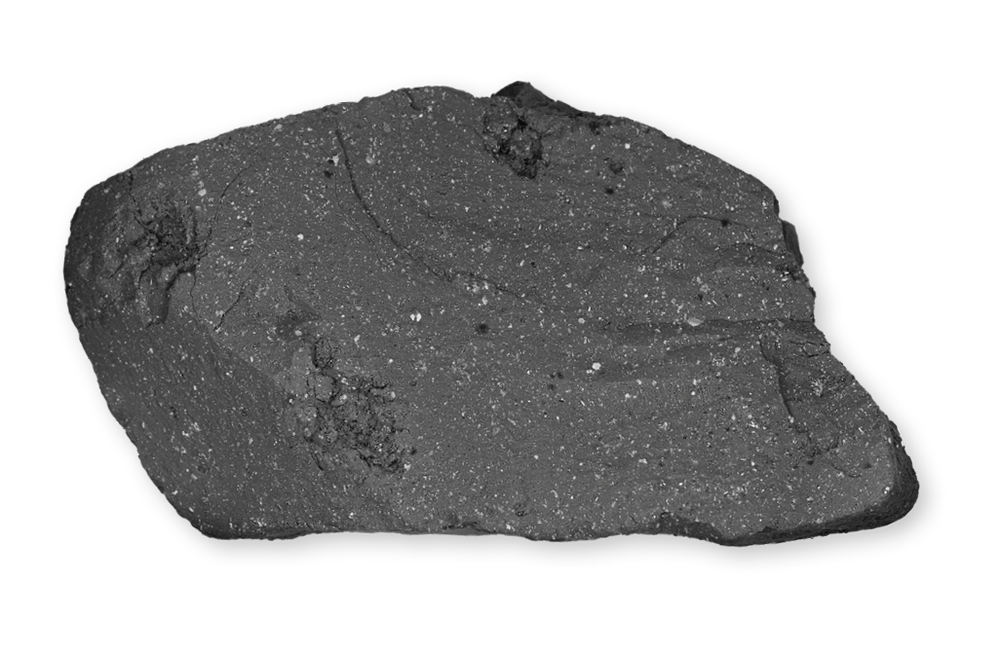
With the exception of a few bodies that have grown into larger 'almost planets' – such as the dwarf planets Ceres and Pluto and the asteroid Vesta, which have a similar shell structure to the planets – these leftover small bodies are barely changed witnesses to the earliest period of the Solar System. As such, they relate the first stages of planet formation and development, especially in relation to Earth, Mercury, Venus and Mars. Interestingly, recent studies of some of the approximately 50,000 meteorites that have fallen to Earth and are now in special collections, and spectral observations with large telescopes on Earth and in space, have shown that asteroids contain water in the form of ice. The further away from the Sun they were formed, the more ice they contain. Thrillingly, their material also includes organic compounds.
The complete programme
Back to the DLR Institute of Planetary Research and Sample A0112. Researchers began by visually examining their granule from asteroid Ryugu, which weighs 5.1 milligrams and measures 3046 by 1823 micrometres. To protect the 'Berlin Sample' from contamination or oxidation, they made their initial measurements inside a sealed sample container. High-resolution 3D images were taken from different sides using a digital microscope, so as to describe the 3D shape. The grain is black with a surface as dark as charcoal and tiny, micrometre-sized lighter elements inlaid. The first infrared spectroscopy measurements were also carried out through a glass panel using near-, mid-, far-infrared wavelengths and visible light, to determine its minerals and any organic substances and map their distribution in the small grain. In this context, ‘organic’ refers to carbon or hydrocarbon compounds.
Asteroid (162173) Ryugu

The target of the Hayabusa2 mission was discovered on 10 May 1999 by the LINEAR project, run by the Massachusetts Institute of Technology's Lincoln Laboratory for the systematic detection and tracking of near-Earth objects. It has a diameter of around 900 metres and a shape reminiscent of a rough diamond with eight faces – although, its northern and southern hemispheres are almost round. Ryugu is a carbon-rich 'C'-type asteroid with a mass of about half a billion tonnes. With a density of 1.2 grams per cubic centimetre, Ryugu is very light and probably full of cavities. Asteroids of this size tend not to be made up of caked rock units, but are held together loosely due to gravity – a 'rubble pile'. Ryugu orbits the Sun every 475 days, during which the asteroid intersects with Earth's orbit twice. Ryugu does not pass dangerously close to Earth.
Dolomite, snakestone and frogstone
The analyses revealed a broad spectrum of minerals and substances on Ryugu that at first glance seemed almost Earth-like. Layered silicates make up around 20 percent of the mass of the samples, made up of minerals such as serpentinite ('snakestone') and saponite ('frogstone') which have a crystalline structure consisting of silicon-oxygen tetrahedra that lie on top of each other in carpet-like layers. In between, there is space for hydroxyls – oxygen-hydrogen compounds – which indicate that water must have played a role in the formation and development of this type of asteroid.
One surprising and significant feature is the occurrence of the magnesium carbonate dolomite, known from the world-famous Dolomites in Italy, alongside other carbonates such as iron and sulphur, as well as more exotic minerals. The iron and magnesium-rich silicates olivine or pyroxene, which are typical of many other planetary bodies and found in many meteorites, were observed less frequently here. The sample grain examined had a density of about 1.3 grams per cubic centimetre which, allowing for measurement errors, fits well with the overall determination of Ryugu's density. It is thought that more than a third of the asteroid consists of cavities.
The various research teams soon noticed similarities to a very rare group of meteorites called the 'CI class'. The 'C' stands for carbon and the 'I' stands for Ivuna – a class of meteorite named after the Ivuna meteorite, found in Tanzania in 1938. There are only nine CI specimens in collections on Earth. Although these meteorites are carbon-rich, they are not made up of tiny, fused globules known as chondrules, but rather of breccia – parent rock that has been shattered by collisions and is full of cracks, fractures and angular elements. The Ryugu samples are most similar to CI chondrite meteorites but are more chemically pristine. The chemical composition of the Ryugu samples is a closer match to the Sun's photosphere than to the composition of any other natural samples studied in laboratories.
Formed in the icy depths of the Solar System
Analyses carried out at DLR's Planetary Spectroscopy Laboratory, the Museum of Natural History in Berlin and specialist firm Bruker Nano Analytics, indicate that Ryugu must have formed at a great distance from the Sun as part of a much larger parent body. It is very cold there, minus 200 degrees Celsius or even colder, and there is far too little solar energy for changes and chemical reactions to take place. Water and carbon dioxide are only stable there in the form of ice. According to estimates by teams involved in evaluating the sample in Japan and Germany, this development probably occurred very shortly after the formation of the Solar System; perhaps only two or three million years later. The only heat that may have altered the asteroid, for a relatively short period of time, was generated by the decay of radioactive aluminium isotopes – so traces of these changes are rare in the samples.
Could Ryugu have originated in the Kuiper Belt – sometimes also referred to as the Kuiper-Edgeworth Belt – beyond the orbits of Uranus and Neptune, home to the icy dwarf planets Pluto, Eris and Makemake, and hundreds of thousands of comets? This inevitably gives rise to two key questions: How did Ryugu, now orbiting so closely around the Sun, get to the inner Solar System? And is it actually an asteroid? Could it, in fact, be a comet that has shed its characteristic volatile substances over billions of years? After all, 33 different amino acids were identified in the samples, which are also found on comets. Ryugu's journey to the inner Solar System could have been initiated by the fragmentation of its parent body and was perhaps accelerated by one of the large planets. But that would have happened when Ryugu was already travelling within the outer Solar System one billion years ago, already an old, dead lump of matter.
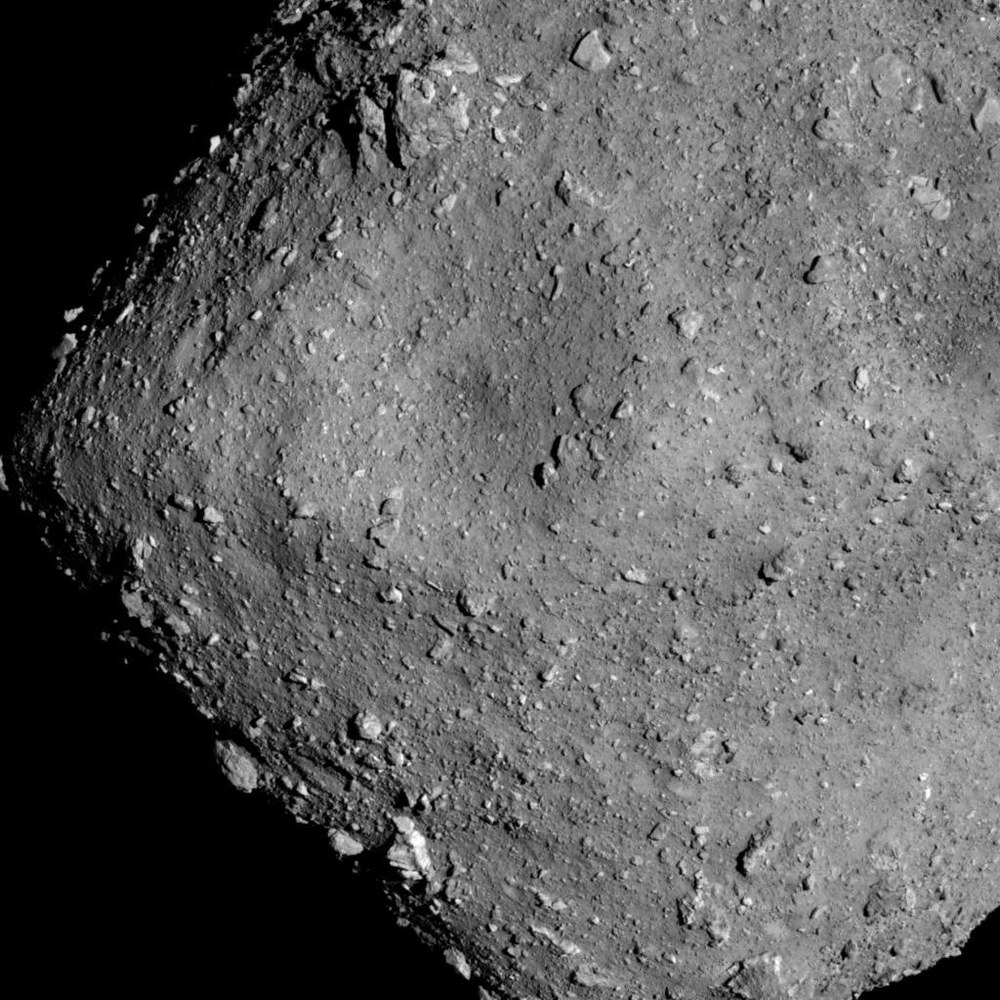
JAXA/University of Tokyo/Kochi University/Rikkyo University/Nagoya University/Chiba Institute of Technology/Meiji University/Aizu University/AIST
During the analysis of the Ryugu sample in the DLR laboratory, involving many measurements taken with a wide variety of devices, one particular observation with a microscope provided a special insight: the discovery of three 'craters' on the tiny speck of dust. Such depressions are caused by micrometeorites hitting into the asteroid at speeds of over ten kilometres per second. The angular rock fragments on the surface then weather into dust over the course of billions of years.
The laboratory team at DLR in Berlin-Adlershof no longer show any signs of trepidation when it comes to dealing with this 4.5-billion-year old sliver of the Solar System. It is almost astonishing how routine such processes have become for them. No hands tremble at the importance of the task; on the contrary in fact, the Institute is looking forward to the arrival of three more grains of dust from Ryugu, probably again in one of those yellow delivery vans.

Hayabusa2 – Coming Home!
Your consent to the storage of data ('cookies') is required for the playback of this video on Youtube.com. You can view and change your current data storage settings at any time under privacy.
An article by Ulrich Köhler from DLRmagazine 175.

